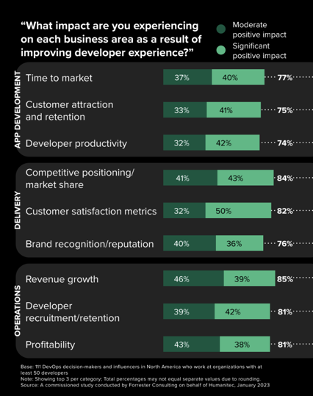How Dynamic Internal Developer Platforms Boost Developer Experience and Productivity
Discover how Platform Engineering and dynamic Internal Developer Platforms can impact business metrics like revenue, time to market, and customer satisfaction.
Join the DZone community and get the full member experience.
Join For FreeWhile we know adopting platform engineering and Internal Developer Platforms (IDPs) can drive DevOps efficiency, how exactly does this translate to real business value? And how can IDPs help organizations meet their overall business goals?
The impact an IDP has on broader business performance reaches far and wide. It can significantly affect key value drivers such as improving time to market (TTM), productivity, and customer satisfaction (which we'll dive into later). All of which are critical to helping businesses stay ahead of the curve. Whether the business priority is creating new revenue streams, digital transformation, or slashing lead time, it's crucial that organizations understand the role platform engineers will play in delivering IDPs that can support overarching goals. As Lee Ditiangkin points out:
"The companies that invest in shorter innovation cycles, faster time to market, and shipping new features on time will outperform their competitors."
How Platforms Drive Innovation and Affect Key Business Metrics
In a nutshell, an IDP offers a curated set of tools and processes that are easily consumed, improve developer experience (DevEx), and boost productivity. Recent research also shows how platform engineering initiatives and dynamic IDPs help drive performance across several areas of the wider organization. According to Forrester's recent Opportunity Snapshot:
"Tech leaders invest in IDPs and platform engineering teams to increase revenue through faster time to market (TTM) and improved customer satisfaction."
With frictionless and effective self-service capabilities that support a better DevEx, teams can reduce lead time and thus TTM, which ultimately helps boost the bottom line. In fact, according to the Forrester study, 77% of DevOps teams can shorten TTM, while 85% have experienced revenue growth as a result of improving DevEx. In short, using an IDP to keep developers happy and ensure they have an awesome experience equates to tangible organizational impact and better results. Let's take a closer look at some of those key metrics business leaders are interested in and what effect an IDP can have.

Reducing Time to Market and Gross Burn
Businesses use TTM to define how long it takes to develop a new product or service, enter the market, and generate revenue. This makes it one of the most important business metrics and, therefore, essential to include when building your IDP argument. As Lee Ditiangkin explains, "With an IDP, developers can self-serve all the tech and tools they need, reducing time wasted waiting on Ops. IDPs also make making architectural changes on applications easier, which you need for rapid iterations. The result is a boost in productivity for developers and operations, enabling us to react faster to a competitive landscape."
Another key metric impacted by the use of an IDP is your burn rate. Better managing idle infrastructure with the ability to detect and pause unused environments can significantly reduce high monthly cloud spend and, therefore, burn. For larger organizations, opting for a cloud vendor-neutral platform can be extremely advantageous, offering them the ability to switch easily between different vendors.
Finding and Retaining Talent
IDPs can vastly improve DevEx, which has the potential to help retain talented staff and creates more appeal for prospective employees. For example, excessive cognitive load can be caused by an inability to self-serve and the need to manage a rapidly growing landscape of tools, which is often the culprit of high turnover from DevOps burnout. By enabling developers and Ops to focus on their respective tasks without putting each team back into their original siloes, IDPs allow a more productive, efficient way of working. This, in turn, helps drive employee satisfaction and is a big appealing factor when it comes to attracting new talent. With the skills shortage ongoing, businesses that don't take action risk drastically hindering their ability to meet critical goals, such as slashing lead time and shortening time to market. According to Gartner,
"Investing heavily in better developer experience is the best way to safeguard developers' creative work and the key to their productivity. This results in happier engineers and helps your organization."
Driving Digital Transformation
Let's say your large-scale enterprise depends on legacy systems but wants to go cloud-native. In this situation, many might opt for Kubernetes (K8s). While this may work for smaller teams on new projects, at scale, things can turn crazy with complexity.
K8s is not a one-size-fits-all engineering solution, regardless of your organization's expectations. This boils down to the simple fact that teams often underestimate the extra developer cognitive load that can be caused by K8s adoption. Not to mention the resulting decrease in developer productivity, which slows down cycle release times and, very soon, your ability to innovate. Opting for an IDP solves this problem by enabling platform engineers to provide abstraction layers on top of K8s and, ultimately, help mitigate the risk of your digital transformation initiative failing.
Summary
No one knows what the future holds. But what we do know is that in the face of a potential financial crisis, the ability to drive creativity and innovation is non-negotiable, which is why developers must be able to work efficiently and self-serve in everything they need to do so. A well-oiled DevOps setup has the power to make a real impact on wider business metrics and key value drivers, such as customer satisfaction and time to market. Those organizations that recognize this act fast and invest in platform engineering and IDPs stand to outperform competitors and gain a bigger market share.
Opinions expressed by DZone contributors are their own.

Comments